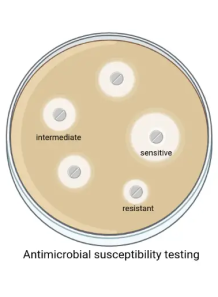Anti-microbial test for Candida albican
- Product Code: 35520
to test the anti-microbial activity and efficacy
Standard protocol for an anti-microbial test against Candida albicans:
Materials Needed:
- Candida albicans strain (e.g., ATCC 90028)
- Sabouraud dextrose broth or RPMI-1640 broth with MOPS buffer
- Sabouraud dextrose agar or Mueller-Hinton agar supplemented with 2% glucose and 0.5 μg/mL methylene blue
- Antimicrobial agent(s) to be tested
- Sterile petri dishes
- Sterile swabs or spreaders
- Incubator
- Microbial loop or inoculating needle
Procedure:
1. Preparation of Candida Culture:
a. Inoculate Candida albicans into Sabouraud dextrose broth or RPMI-1640 broth with MOPS buffer.
b. Incubate the broth culture at 35-37°C for 18-24 hours to obtain a fresh, actively growing culture.
2. Standardization of Inoculum:
a. Adjust the turbidity of the broth culture to match the 0.5 McFarland turbidity standard (approximately 1-5 x 10^6 CFU/mL).
b. This can be done by diluting the broth culture with sterile saline or broth.
3. Preparation of Agar Plates:
a. Prepare Sabouraud dextrose agar or Mueller-Hinton agar supplemented with 2% glucose and 0.5 μg/mL methylene blue according to the manufacturer's instructions.
b. Allow the agar to solidify and dry before use.
4. Inoculation of Agar Plates:
a. Dip a sterile swab or spreader into the standardized inoculum and streak it evenly onto the agar plate to obtain a uniform lawn of fungal growth.
b. Allow the inoculum to dry for a few minutes before proceeding.
5. Application of Antimicrobial Agent(s):
a. Depending on the type of antimicrobial agent (e.g., discs, wells, or strips), follow the appropriate method for applying the agent(s) to the inoculated agar plate.
b. For disc diffusion method, place antimicrobial discs onto the inoculated agar surface using sterile forceps.
c. For well diffusion method, cut wells into the agar using a sterile cork borer or similar tool, and pipette the antimicrobial solution into the wells.
d. For antimicrobial strips, place the strip onto the inoculated agar surface according to the manufacturer's instructions.
6. Incubation:
a. Incubate the inoculated agar plates at 35-37°C for 20-24 hours.
7. Interpretation:
a. After incubation, examine the plates for zones of inhibition around the antimicrobial agent(s).
b. Measure the diameter of the zones of inhibition in millimeters (mm) using a caliper or ruler.
c. Refer to standard guidelines or interpretive criteria (e.g., CLSI or EUCAST) to determine the susceptibility or resistance of Candida albicans to the tested antimicrobial agent(s).
| Step | Procedure | Expected Result | |||
|---|---|---|---|---|---|
| There is no item to display. | |||||
to test the anti-microbial activity and efficacy
Standard protocol for an anti-microbial test against Candida albicans:
Materials Needed:
- Candida albicans strain (e.g., ATCC 90028)
- Sabouraud dextrose broth or RPMI-1640 broth with MOPS buffer
- Sabouraud dextrose agar or Mueller-Hinton agar supplemented with 2% glucose and 0.5 μg/mL methylene blue
- Antimicrobial agent(s) to be tested
- Sterile petri dishes
- Sterile swabs or spreaders
- Incubator
- Microbial loop or inoculating needle
Procedure:
1. Preparation of Candida Culture:
a. Inoculate Candida albicans into Sabouraud dextrose broth or RPMI-1640 broth with MOPS buffer.
b. Incubate the broth culture at 35-37°C for 18-24 hours to obtain a fresh, actively growing culture.
2. Standardization of Inoculum:
a. Adjust the turbidity of the broth culture to match the 0.5 McFarland turbidity standard (approximately 1-5 x 10^6 CFU/mL).
b. This can be done by diluting the broth culture with sterile saline or broth.
3. Preparation of Agar Plates:
a. Prepare Sabouraud dextrose agar or Mueller-Hinton agar supplemented with 2% glucose and 0.5 μg/mL methylene blue according to the manufacturer's instructions.
b. Allow the agar to solidify and dry before use.
4. Inoculation of Agar Plates:
a. Dip a sterile swab or spreader into the standardized inoculum and streak it evenly onto the agar plate to obtain a uniform lawn of fungal growth.
b. Allow the inoculum to dry for a few minutes before proceeding.
5. Application of Antimicrobial Agent(s):
a. Depending on the type of antimicrobial agent (e.g., discs, wells, or strips), follow the appropriate method for applying the agent(s) to the inoculated agar plate.
b. For disc diffusion method, place antimicrobial discs onto the inoculated agar surface using sterile forceps.
c. For well diffusion method, cut wells into the agar using a sterile cork borer or similar tool, and pipette the antimicrobial solution into the wells.
d. For antimicrobial strips, place the strip onto the inoculated agar surface according to the manufacturer's instructions.
6. Incubation:
a. Incubate the inoculated agar plates at 35-37°C for 20-24 hours.
7. Interpretation:
a. After incubation, examine the plates for zones of inhibition around the antimicrobial agent(s).
b. Measure the diameter of the zones of inhibition in millimeters (mm) using a caliper or ruler.
c. Refer to standard guidelines or interpretive criteria (e.g., CLSI or EUCAST) to determine the susceptibility or resistance of Candida albicans to the tested antimicrobial agent(s).
| Mechanism | - |
| Appearance | - |
| Longevity | - |
| Strength | - |
| Storage | - |
| Shelf Life | - |
| Allergen(s) | - |
| Dosage (Range) | - |
| Recommended Dosage | - |
| Dosage (Per Day) | - |
| Recommended Dosage (Per Day) | - |
| Mix Method | - |
| Heat Resistance | - |
| Stable in pH range | - |
| Solubility | - |
| Product Types | - |
| INCI | - |
Purchase History for
Cart
No products



